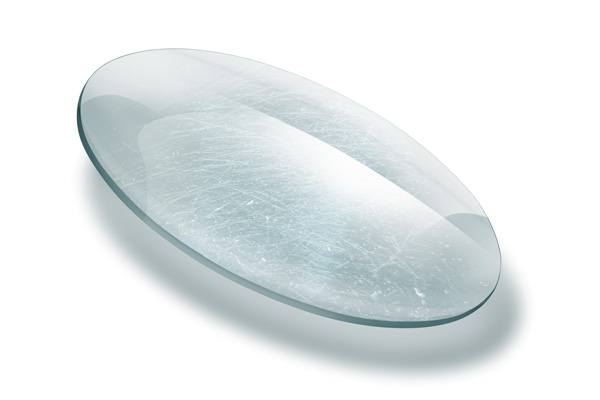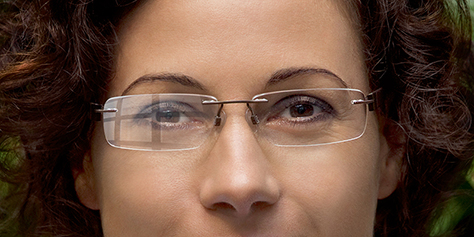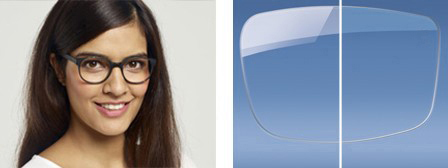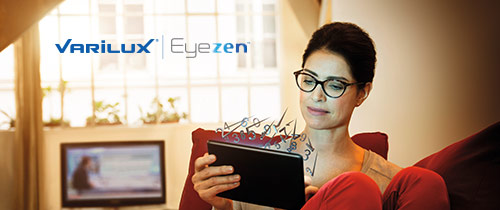For specific features of each beam treatment click more information.
ADDITIONAL TREATMENTS
In Prodevisión we work with the best treatments in graduated lenses.
ANTI-SCRATCH:
All our lenses include anti-scratch treatment, which is a lacquer applied on the surface of the lenses, which makes them harder and resistant to abrasions. This does not mean that the lenses will not scratch if they are misused. To scratch less, we recommend wet cleaning and drying with microfiber or cotton suede.

Lens without anti-scratch treatment
Lens with anti-scratch treatment
Anti-reflective treatment is recommended.
Anti-glare is a multi-layer treatment that is applied to the surface of the lens. Its quality depends on the number of layers it takes, the more layers, the better the treatment, increasing the transmittance to 99.9%, eliminating practically all the reflections. When you use the anti-glare treatment you do not have reflections, the transparency of the lens gives you the sensation of not wearing glasses in front of the eye, providing a much sharper and more natural vision.

In Prodevisión we work with two qualities of anti-reflective treatment:
Multilayer anti-reflective:
It is a quality anti-glare treatment, built with a nanoparticle technology consisting of:
- Anti-scratch: is a layer adapted to the base surface of the lens.
- Multi-layered blue-tinted anti-reflective with 99% transparency.
- A cleaning layer, which repels water, dirt and grease.
All this ensures greater resistance to scratching.
Multilayer anti-reflective Plus
It is based on the previous antireflection. In addition, Anti-reflective Plus lenses, with blue residual reflection, have 20% less light reflectance and therefore less discomfort due to glare and residual reflections. In the anti-reflective Multicapa Plus, the nine ultra-thin layers that compose it are more compact, obtaining lenses whose surface is up to three times harder than the lenses with multilayer anti-glare.


Its fifth layer is anti-static, it prevents static electricity from the surface of the lens that is produced when cleaning. In this way, our multi-layered anti-glare lenses stay clean longer.
The multilayer anti-glare lenses plus have an extra-large surface that facilitates their cleaning thanks to their hydrophobic and lipophobic properties. Liquids and dirt slide on the surface of the lens without leaving a trace.
In summary, the multi-layer organic anti-reflective lenses that we offer in Prodevisión are: three times more scratch resistant, repellent dirt, very easy to clean and more transparent and comfortable for your eyes than anti-glare multi-layer lenses.
SMARTPHONE PREVENTION TREATMENT
Crizal Previt is an anti-glare treatment, suitable for the continuous use of electronic devices such as PCs, tablets and mobile devices, selectively filtering harmful light (violet blue and UV), while letting pass the Useful light.
Blue-violet light is one of the risk factors for AMD (age-related macular degeneration) and unprotected UV exposure can cause cataracts and ocular pathologies.
This treatment, applied to graduated lenses, blocks 20% of harmful blue-violet light, reducing the retinal cell death rate by 25% and providing 25 times more protection against ultraviolet rays.
Thanks to LightScan technology, Crizal Prevencion protects your eyes from harmful radiation, providing lasting clarity of vision with the most complete protection against reflections, scratches, fingerprints, dust and water.
EYEZEN: OCCUPATIONAL LENSES
EYEZEN is the new monofocal lens for everyday use, manufactured by ESSILOR, for people who have visual defects and for people who do not have it and who use digital devices for many hours.
This lens has three levels of optimization according to the user profile:
- EYEZEN INITIAL 0.4: for young people between 20-34 years.
- EYEZEN ACTIVE 0.6: Pre-presbytes between 35-44 years.
- EYEZEN ACTIVE + 0.85: Incipient presets that have not been corrected in about 45-50 years.
The advantages of the EYEZEN lens to the user are:
- An optimized view based on age.
- Reduces visual fatigue, even with prolonged use of electronic devices.
- Improves reading in small print.
- It is the only lens that has 0.4 help for young users who have problems in close and do not know how to solve them.
- Vision in high definition.
- Includes Crizal Prevencion treatment (explained above), which protects against ultraviolet rays and blue-violet light, very harmful to the eye.
Thanks to their Eyezen Focus technology, these single-lens lenses provide extra power for each version (Initial, Active or Active +) at the bottom of the lens that helps during accommodative efforts and reduces visual fatigue.

GRAY AND BROWN PHOTOCROMATIC:
Photochromic lenses, also called smart lenses, are those that darken when exposed to sunlight. The one that darken more or less depends on the intensity of light that they receive, if the day is cloudy they will darken less than if it is sunny.

The basic principle of these graduated lenses is that they have a treatment layer composed of organic molecules that have a reversible darkening effect due to a chemical oxidation / reduction reaction.
Our photocomic lenses have a much shorter reaction time than conventional lenses, darkening faster by 20% and brightening up to 50% faster than normal lenses.
Photochromic lenses are manufactured in reductions 1.5, 1.6 and 1.67.
These lenses can be darkened in two different shades, brown and gray, to choose the one that best goes to the glasses (eg, if the glasses are black, a gray one will look better) or the one you like the most.
Also indicate that the photochromic lenses are fully compatible with the anti-glare treatment, thus having all the factors of comfort, vision without reflection and sun protection
 + 34 617 357 588
+ 34 617 357 588